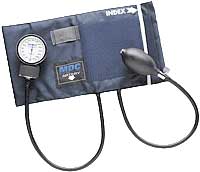Home » Hospital & Durable Medical Equipment » Learning More About Your Blood Pressure & BP Monitors » Learning More About Your Blood Pressure & BP Monitors
Learning More About Your Blood Pressure & BP Monitors

Standard Sphygmomanometer - Adult Cuff
Retail Price: $46.42
Your Price: $35.89

White Shock Proof Sphygmomanometer
Retail Price: $149.13
Your Price: $118.64
 Unit: single
Unit: single
Digital and manual blood pressure monitors measure the force of blood pumped by the heart against artery walls. Blood pressure measurements can also provide information on the size of the artery and elasticity of the artery. The most accurate method to measure blood pressure uses a sphygmomanometer. Pressure of pumping blood causes a column of mercury to rise in the sphygmomanometer, using gravity to measure blood pressure. Today, other blood pressure monitors - both manual and automatic - are available to quickly and accurately measure blood pressure.
Our blood pressure monitors come in a variety of styles, including:
- Upper arm automatic blood pressure monitor with extra large displays and storage cases
- Upper arm auto-inflation blood pressure monitors with digital displays and automatic shut-offs
- Upper arm automatic blood pressure monitors with memory storage and printers
- Automatic finger blood pressure monitors with memory recall
- Wrist-calibrated blood pressure monitors with memory and storage cases
- Sphygmomanometers with portable stands, manual inflation
- Blood pressure monitor replacement parts, such as blood pressure monitor cuffs, AC adaptors and tubing.
Blood pressure readings are stated as two numbers:
Systolic blood pressure- maximum arterial pressure each time the heart contracts; Diastolic blood pressure - arterial pressure when the heart is at rest.
Blood pressure is considered elevated at a systolic pressure of 140 and a diastolic pressure of 90 or 140/90. High blood pressure affects approximately 20 percent of adults and is more prevalent in men than women and in Blacks than Caucasians.
Common Causes of High Blood Pressure:
- Obesity
- Salty diets
- Alcoholism
- Chronic anxiety or temporary stress
- Arteriosclerosis - hardening of the arteries
- Kidney dysfunction
- Diabetes
- Gout
- Medications including appetite suppressants, tranquilizers, diuretics and vasodilators
- Anesthesia
Because there are no symptoms when a person’s blood pressure is too high, it is vital that blood pressure be checked during regular intervals. Individuals who are diagnosed with high blood pressure (hypertension) must manage their condition to avoid complications that can cause heart attacks, stroke, kidney failure and even death. Home blood pressure monitors help patients manage high blood pressure by alerting them to high blood pressure readings.
Treatment of High Blood Pressure:
- Medications
- Diet modifications
- Exercise
- Weight loss
- Salt reduction
- Alcohol reduction
- Regular blood pressure monitoring















